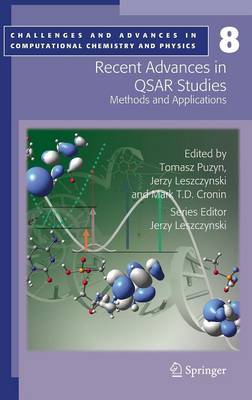Challenges and Advances in Computational Chemistry and Physics
1 primary work
Book 8
Recent Advances in QSAR Studies
Published 3 December 2009
Since the inception of this volume, the world's nancial climate has radically changed. Theemphasishasshiftedfromboomingeconomiesandeconomicgrowth totherealityofrecessionanddiminishingoutlook. Witheconomicdownturncomes opportunity,inallareasofchemistryfromresearchanddevelopmentthroughto productregistrationandriskassessment,replacementsarebeingsoughtforcostly time-consumingprocesses. Leadingamongstthereplacementsaremodelswithtrue predictivecapability. Ofthesecomputationalmodelsarepreferred. This volume addresses a broad need within various areas of the "chemical industries", from pharmaceuticals and pesticides to personal products to provide computationalmethodstopredicttheeffects,activitiesandpropertiesofmolecules. Itaddressestheuseofmodelstodesignnewmoleculesandassesstheirfateand effectsbothtotheenvironmentandtohumanhealth. Thereisanemphasisrunning throughoutthisvolumetoproducerobustmodelssuitableforpurpose. Thevolume aimstoallowthereaderto nddataanddescriptorsanddevelop,discoverandutilise validmodels. Gdansk, ' Poland TomaszPuzyn Jackson,MS,USA JerzyLeszczynski Liverpool,UK MarkT. D.
Cronin May2009 CONTENTS Part I Theory of QSAR 1 QuantitativeStructure-ActivityRelationships(QSARs)- ApplicationsandMethodology...3 Mark T. D. Cronin 1. 1. Introduction...3 1. 2. PurposeofQSAR...4 1. 3. ApplicationsofQSAR...4 1. 4. Methods...5 1. 5. TheCornerstonesofSuccessfulPredictiveModels ...7 1. 6. AValidated(Q)SARoraValidPrediction? ...9 1. 7. UsinginSilicoTechniques ...9 1. 8. NewAreasforinSilicoModels...11 1. 9. Conclusions...11 References ...11 2 TheUseofQuantumMechanicsDerivedDescriptorsin ComputationalToxicology...13 Steven J. Enoch 2. 1. Introduction...13 2. 2. TheSchrodingerEquation...15 2. 3. Hartree-FockTheory...17 2. 4. Semi-EmpiricalMethods:AM1andRM1...18 2. 5. ABInitio:DensityFunctionalTheory...19 2. 6. QSARforNon-ReactiveMechanismsofAcute(Aquatic) Toxicity...19 2. 7. QSARsforReactiveToxicityMechanisms...21 2. 7. 1. AquaticToxicityandSkinSensitisation...21 2. 7. 2. QSARsforMutagenicity ...24 2. 8. FutureDirectionsandOutlook...25 2. 9. Conclusions...26 References ...26 vii viii Contents 3 MolecularDescriptors...29 Viviana Consonni and Roberto Todeschini 3. 1. Introduction...29 3. 1. 1. De nitions...29 3. 1. 2. History...31 3. 1. 3. Theoreticalvs.
ExperimentalDescriptors...33 3. 2. MolecularRepresentation ...35 3. 3. TopologicalIndexes...38 3. 3. 1. MolecularGraphs...38 3. 3. 2. De nitionandCalculationofTopologicalIndexes(TIs) 39 3. 3. 3. Graph-TheoreticalMatrixes...42 3. 3. 4. ConnectivityIndexes ...48 3. 3. 5. CharacteristicPolynomial ...50 3. 3. 6. SpectralIndexes ...53 3. 4. AutocorrelationDescriptors ...
Cronin May2009 CONTENTS Part I Theory of QSAR 1 QuantitativeStructure-ActivityRelationships(QSARs)- ApplicationsandMethodology...3 Mark T. D. Cronin 1. 1. Introduction...3 1. 2. PurposeofQSAR...4 1. 3. ApplicationsofQSAR...4 1. 4. Methods...5 1. 5. TheCornerstonesofSuccessfulPredictiveModels ...7 1. 6. AValidated(Q)SARoraValidPrediction? ...9 1. 7. UsinginSilicoTechniques ...9 1. 8. NewAreasforinSilicoModels...11 1. 9. Conclusions...11 References ...11 2 TheUseofQuantumMechanicsDerivedDescriptorsin ComputationalToxicology...13 Steven J. Enoch 2. 1. Introduction...13 2. 2. TheSchrodingerEquation...15 2. 3. Hartree-FockTheory...17 2. 4. Semi-EmpiricalMethods:AM1andRM1...18 2. 5. ABInitio:DensityFunctionalTheory...19 2. 6. QSARforNon-ReactiveMechanismsofAcute(Aquatic) Toxicity...19 2. 7. QSARsforReactiveToxicityMechanisms...21 2. 7. 1. AquaticToxicityandSkinSensitisation...21 2. 7. 2. QSARsforMutagenicity ...24 2. 8. FutureDirectionsandOutlook...25 2. 9. Conclusions...26 References ...26 vii viii Contents 3 MolecularDescriptors...29 Viviana Consonni and Roberto Todeschini 3. 1. Introduction...29 3. 1. 1. De nitions...29 3. 1. 2. History...31 3. 1. 3. Theoreticalvs.
ExperimentalDescriptors...33 3. 2. MolecularRepresentation ...35 3. 3. TopologicalIndexes...38 3. 3. 1. MolecularGraphs...38 3. 3. 2. De nitionandCalculationofTopologicalIndexes(TIs) 39 3. 3. 3. Graph-TheoreticalMatrixes...42 3. 3. 4. ConnectivityIndexes ...48 3. 3. 5. CharacteristicPolynomial ...50 3. 3. 6. SpectralIndexes ...53 3. 4. AutocorrelationDescriptors ...
